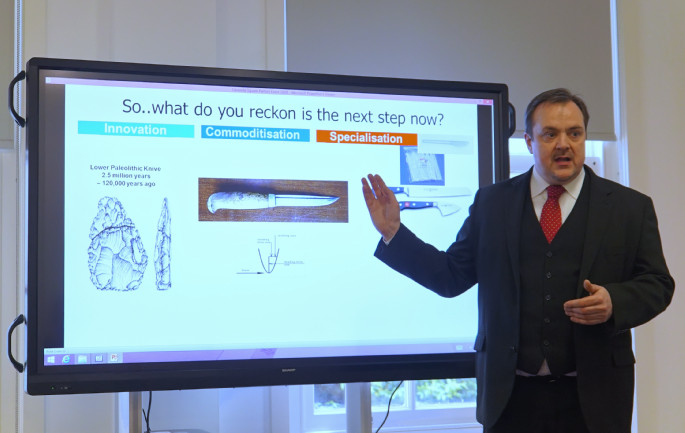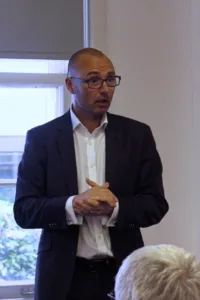 Mike Bailly then came up to introduce some products. Bailly is a veteran of NEC and Samsung and has been working on an approach to the market for Sharp.
Mike Bailly then came up to introduce some products. Bailly is a veteran of NEC and Samsung and has been working on an approach to the market for Sharp.
A knife is a basic tool, Bailly said, but there are thousands of designs optimised for particular jobs. Of course, there are commoditised knives, but they are not appropriate for special or important applications. In the same way, Sharp is interested in differentiated displays.
Sharp has a good brand presence and is known for quality and reliability and of course has its G10 fab for LCD in Sakai.
Bailly then went into the advantages of Sharp’s UV2A technology which enhances contrast. Sharp wants to produce high quality images using direct LCD BLUs with local dimming. It also has slim and light models using edge lighting.
All of the products are 24/7 and the company also has high brightness – even 1500 cd/m2 on a video wall product.
Bailly then went on to look the BigPad which is a large display with an integrated PC that has a very high specification of touch including features such as 200Hz sampling. The BigPad has good anti-glare performance and smooth “anti-finger burn” technology.
Sharp has software for standard whiteboard functions, a content launcher and “Touch Display Link” which is a very feature-rich application for content sharing and communication. Bailly mentioned, while talking about medical applications, that BigPad will have Dicom certification later.
PN-70SC3 is a 70″ 6 point touch unit that still has coated glass but without the pressure-sensitivity, so that price gets down to the level wanted by education, although this is likely to be higher education.
In video walls, Bailly claims the widest range of display specifications. The PN-V551 is a new 55″ 700 cd/m2 video wall product. It has improved white uniformity that is called UCCT (Uniform color calibration technology) for mura and colour correction.
The correction is applied at the pixel level at the factory. An L*ab calibration methodology is used to correct any colour defects on the panel.
Once the mura is gone, the display can have its white point set. This allows a video wall to be well balanced to bring a much more comfortable and natural image. A 2 x 2 matrix wall can be sold at a fifth of the cost of a 100″ single UltraHD, Bailly said.
The PN-H701 is a new 70″ UltraHD monitor and there is no question for Bailly that UltraHD is coming. Sharp has worked to make the set light and attractive with power consumpution of 270W and with an A/R coating, he said. As usual, it is rated for 24/7 applications. The set includes UltraHD rendering of graphic files from the USB.
The monitor uses edge lighting and side and top bezels are 8.8mm, in aluminium, with 14mm at the bottom. The UltraHD can be supported with 4 HDMI inputs (one with HDCP 2.2 and MHL). The inputs are controllable by RS232. It can play back still images up to 8K x 8K which are scaled. Video can be scaled from FullHD, but UltraHD playback needs an external player or system unit.
NVidia has the Quadro K1200 which can drive four PN-H701 monitors that can support 30Hz operation for 8K display at a very good cost.
This kind of configuration has been used in a 15360 x 2160 pixels arrnagement.
Analyst Comment
We asked Sharp about on-site calibration for UCCT displays and we were told that later there will be a method of site calibration and balance. Mura tends not to change so much over time, Bailly said, but there will be a system for colour and brightness compensation.

